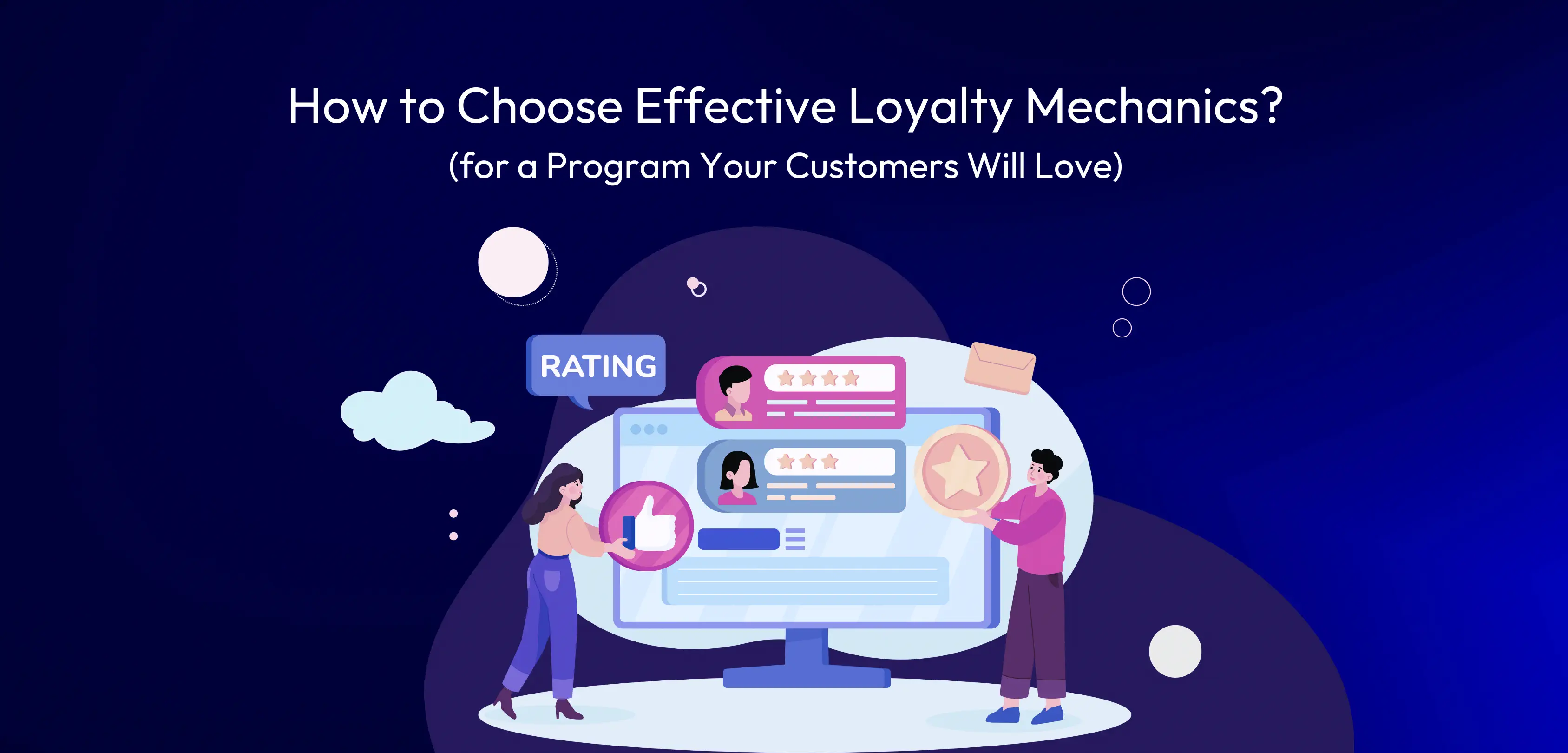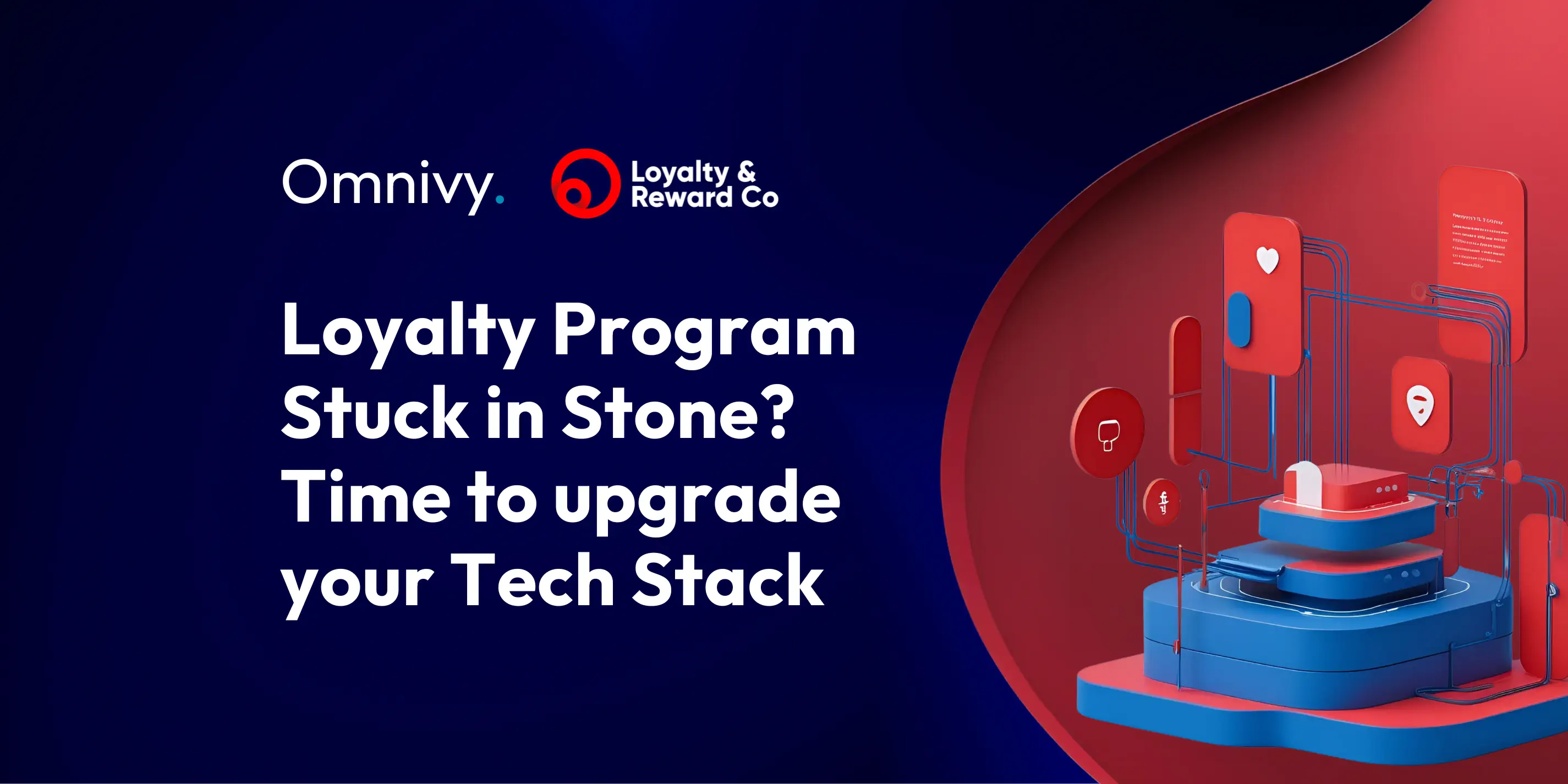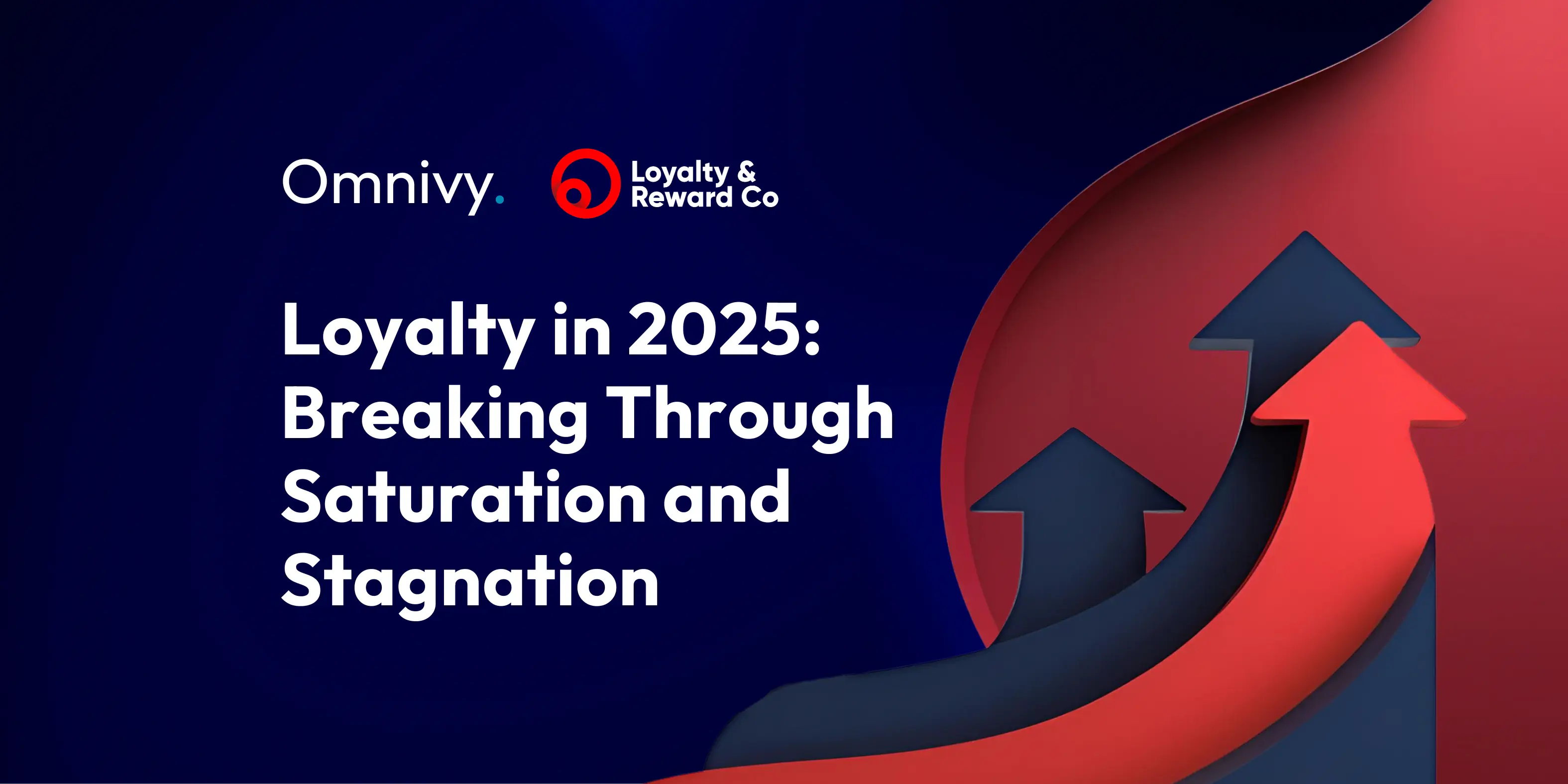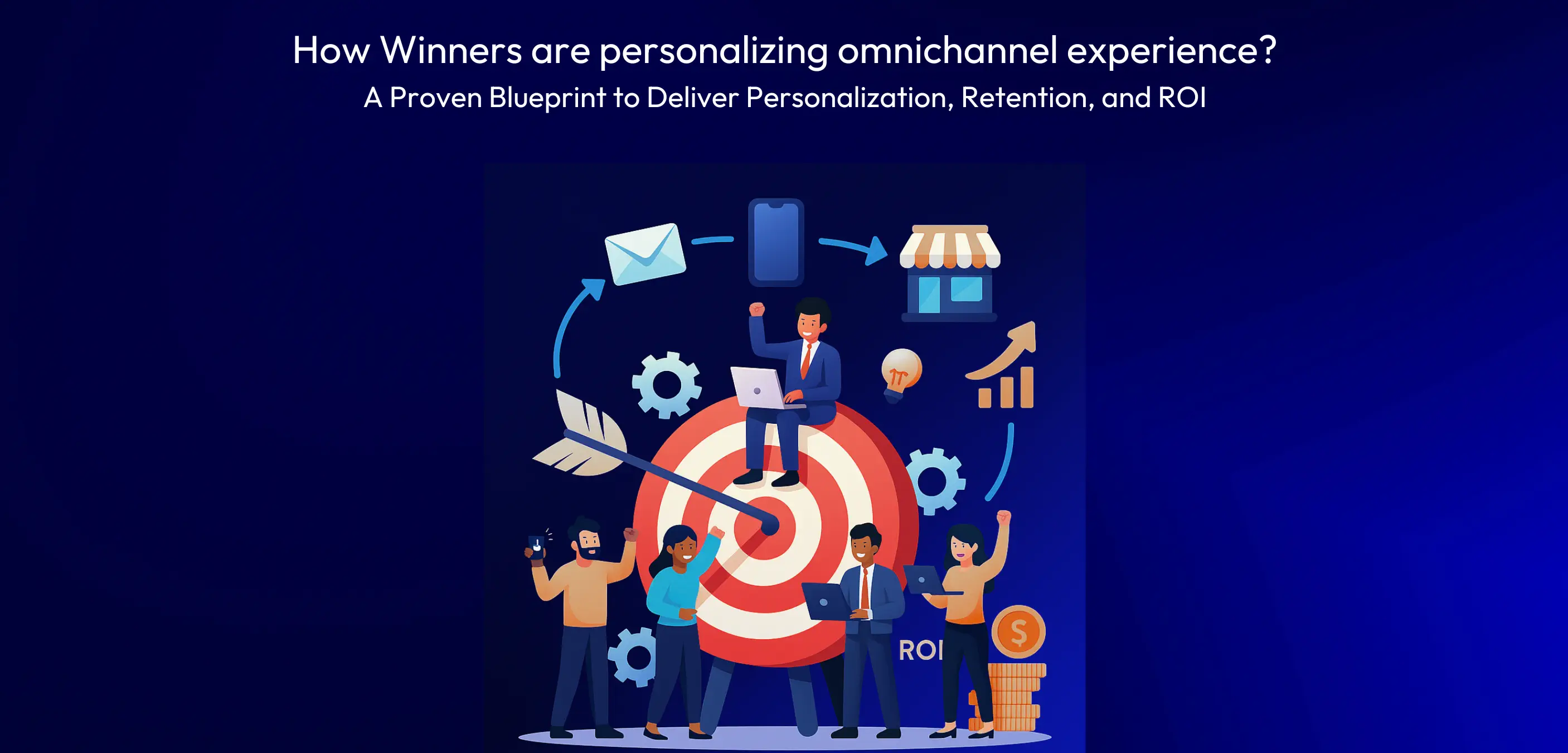In our previous article, we laid the foundation for a strong loyalty strategy, diving deep into the business case and evaluating whether the effort pays off. (If you haven’t read it yet, check it out here: How to Create a Loyalty Program Strategy).
Now, it’s time to move beyond the strategy and focus on the core of any successful loyalty initiative— loyalty mechanics.
Loyalty mechanics determine whether your customers will engage with your program, how frequently they return, and what tangible value they extract from their participation. In other words, they are the secret sauce that keeps customers coming back while driving measurable business growth.
In this article, we’ll break down:
- The different types of loyalty mechanics, their benefits, and limitations.
- The best-fit mechanics for different industries and business models.
- A framework for evaluating which loyalty mechanics will drive the most impact for your brand.
Loyalty Mechanics: What Are They?
At their core, loyalty mechanics are a set of engagement techniques designed to strengthen the bond between a brand and its customers. These tactics go beyond simple transactions; they create emotional loyalty and habitual engagement, making customers feel valued while driving revenue.
Done right, loyalty mechanics can:
- Increase customer lifetime value (CLV) by incentivizing repeat purchases.
- Boost purchase frequency by rewarding desired behaviors.
- Turn customers into brand advocates who refer friends and generate organic growth.
The most common types of loyalty mechanics include:
- Points-based program – customers earn points for transactions and engagements, redeemable for rewards.
- Tiered loyalty program – structured benefits increase as customers ascend through different levels.
- Referral program – customers are rewarded for bringing in new users.
- Rewards-based program – members receive exclusive perks, discounts, or gifts.
- Subscription-based program – customers pay for access to premium benefits.
You can also combine different types to create a hybrid program—the most commonly observed model in the market. This approach merges various mechanics to provide a complete customer experience.
In the following sections, we’ll explore how to choose the right mix and implement them effectively. But before that, let’s ask the fundamental question:
How to Choose the Right Loyalty Mechanics?
As in almost every aspect of marketing and business, the answer is: "It depends!" The choice of specific solutions should be deeply rooted in the specifics of your industry, unique business model, and most importantly, the expectations of your customers. There is no single universal recipe for success, but proven strategies can help you make the best decision.
Most importantly – You don’t have to reinvent the wheel!
Instead of wasting time on blind experimentation, leverage the knowledge and experience of others. Before implementing a solution, consider these key questions:
- Who is your target audience? Are you catering to individual consumers (B2C), business clients (B2B), or employees (B2E)? What resonates with one group may not work for another.
- What are your industry dynamics? A hospitality business requires a different loyalty approach than an e-commerce retailer or financial institution. Your loyalty program must align with your offering and customer needs.
- Do you sell online, in physical stores, or both? Choose mechanics that match your operational structure.
- What technological capabilities do you have? Advanced mechanics like gamification and multi-brand rewards require robust backend support.
- What is your budget? Are you building a high-touch premium experience, or do you need a scalable, cost-efficient program?
- What resources do you have? Do you have access to modern technology and a skilled team? A realistic assessment of your resources is essential. Even with a limited budget, you can create an effective program.
- How do market trends influence loyalty strategies? Are you leveraging innovations like personalization, gamification, or subscription-based models? Keeping up with industry trends can ensure your program remains relevant and appealing.
- How does your program compare to competitors? Have you analyzed competing loyalty programs to understand what works and what doesn’t? Learning from industry leaders (and their missteps) can help you craft a loyalty program that truly stands out.
Remember to Test and Optimize!
Selecting loyalty mechanics is just the beginning. The key to success lies in continuously monitoring program effectiveness and adapting it to evolving customer needs. Don’t be afraid to experiment and test different solutions. Sometimes, it's best to start with simple mechanics and gradually introduce more advanced options.
Need help? Not sure how to set point multipliers or tier thresholds? We’ve got you covered. Contact us, and we’ll ensure your loyalty program is tailored to your business needs—clear, effective, and built for success.
Most Effective Loyalty Mechanics
Points-Based Program: A Timeless Classic That Works!
A points-based loyalty program is one of the most popular and widely recognized loyalty mechanics. In simple terms, customers earn points for purchases and other activities, such as signing up for the program, completing their profile, engaging on social media, or celebrating their birthday. These points can then be redeemed for rewards, discounts, or vouchers.
This highly versatile model works across almost every industry—from e-commerce and retail to hospitality, beauty, and automotive sectors.
Key Features of a Points-Based Program
Earning points for purchases: Customers receive a set number of points per dollar spent (e.g., 1 point per $1). Different multipliers can be applied for specific product categories or services.
Bonus points for additional activities: Enhance customer engagement by rewarding:
- Signing up for the program.
- Shopping on specific days or during promotional hours.
- Completing surveys.
- Subscribing to a newsletter.
- Engaging on social media (e.g., liking pages, sharing posts, leaving reviews).
- Adding items to wishlists or favorites.
- Completing their profile.
Rewards catalog: Customers can redeem points for physical products, discounts, vouchers, or exclusive services. The ability to choose rewards increases satisfaction and engagement.
Clear redemption rules: A well-defined point economy ensures transparency and financial sustainability. Properly setting point values, reward costs, and conversion rates prevents excessive liabilities and ensures profitability.
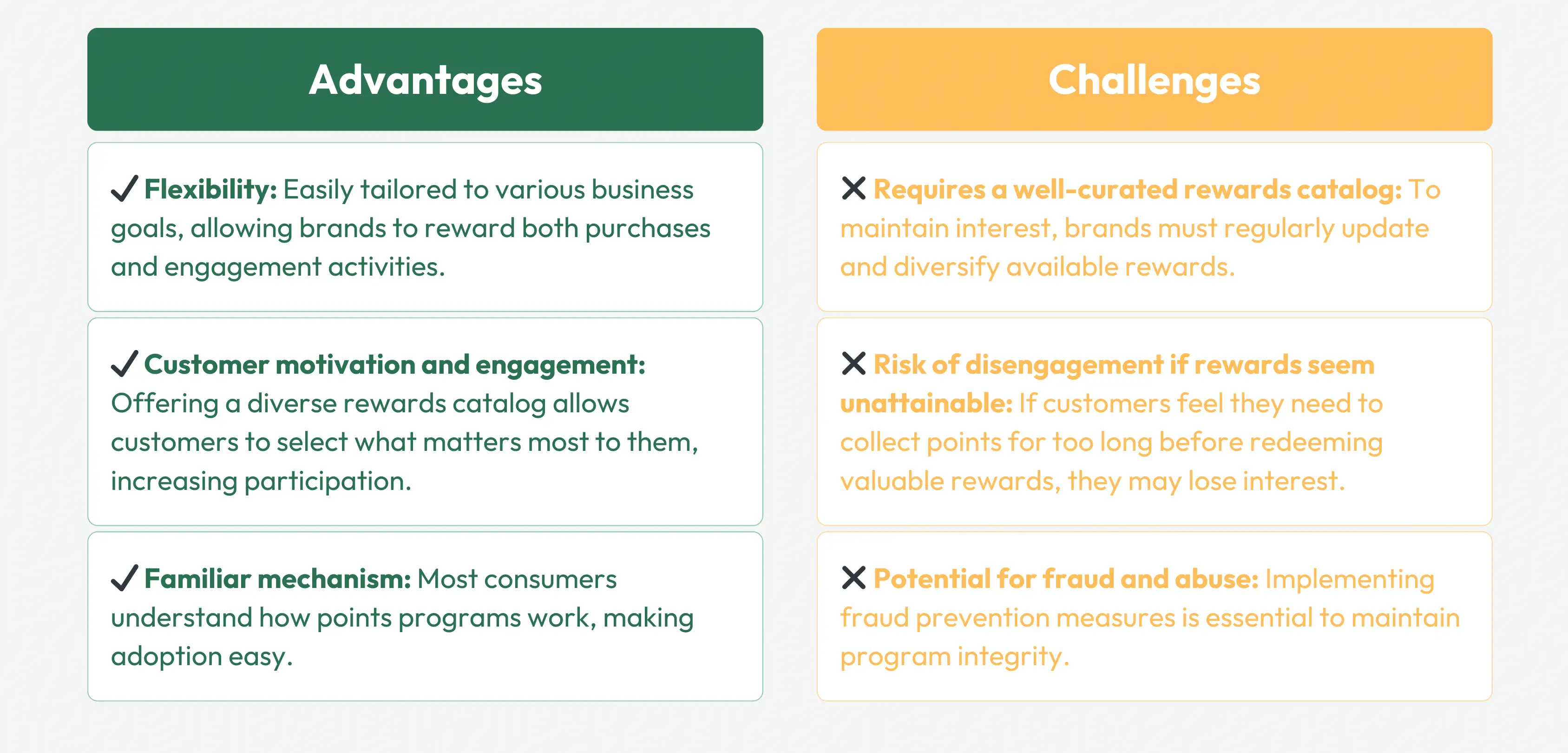
Strategic Best Practices for Points-Based Programs
-
Optimize the point-to-dollar conversion rate. Ensure that the value proposition remains attractive to customers while being financially viable for your business.
-
Offer multiple earning opportunities. Providing diverse ways to collect points increases participation and deepens customer interaction.
-
Balance reward value against required points. High-value rewards should require extended engagement, but smaller, more attainable incentives should also be available.
-
Monitor and refine the program. Regularly track metrics like redemption rates and churn to optimize program effectiveness.
A well-designed points-based program remains one of the most effective loyalty mechanics for driving customer retention and engagement. However, success depends on careful planning, seamless execution, and ongoing optimization.
Tiered Loyalty Programs: Rewarding Long-Term Commitment
Tiered loyalty programs, also known as status-based or multi-level programs, are an advanced version of points-based programs. In addition to collecting loyalty currency (it might be the amount of spent money, or number of air miles flown), customers can progress through different loyalty tiers by meeting specific criteria such as accumulated points, total spending, frequency of engagement, or other brand interactions. Each new tier unlocks increasingly valuable rewards, providing strong motivation for continued participation.
These programs are particularly effective in industries where long-term customer relationships are crucial, such as hospitality, airlines, retail, beauty, and e-commerce platforms.
Key Features of Tiered Programs
- Hierarchical structure: The program consists of multiple levels (tiers), each offering a unique set of benefits.
- Progression criteria: Customers must meet defined requirements to advance (e.g., spending thresholds, number of transactions, engagement activities).
- Increasing rewards: Higher tiers come with more attractive perks such as larger discounts, free shipping, early access to new products, exclusive events, or personal shopping assistants.
- Status maintenance: Many programs require customers to maintain their tier status by consistently meeting engagement requirements, preventing drop-off in activity.
- Branded tier names: Tiers often have aspirational names like “Silver,” “Gold,” “Platinum,” or “VIP” to enhance perceived exclusivity.
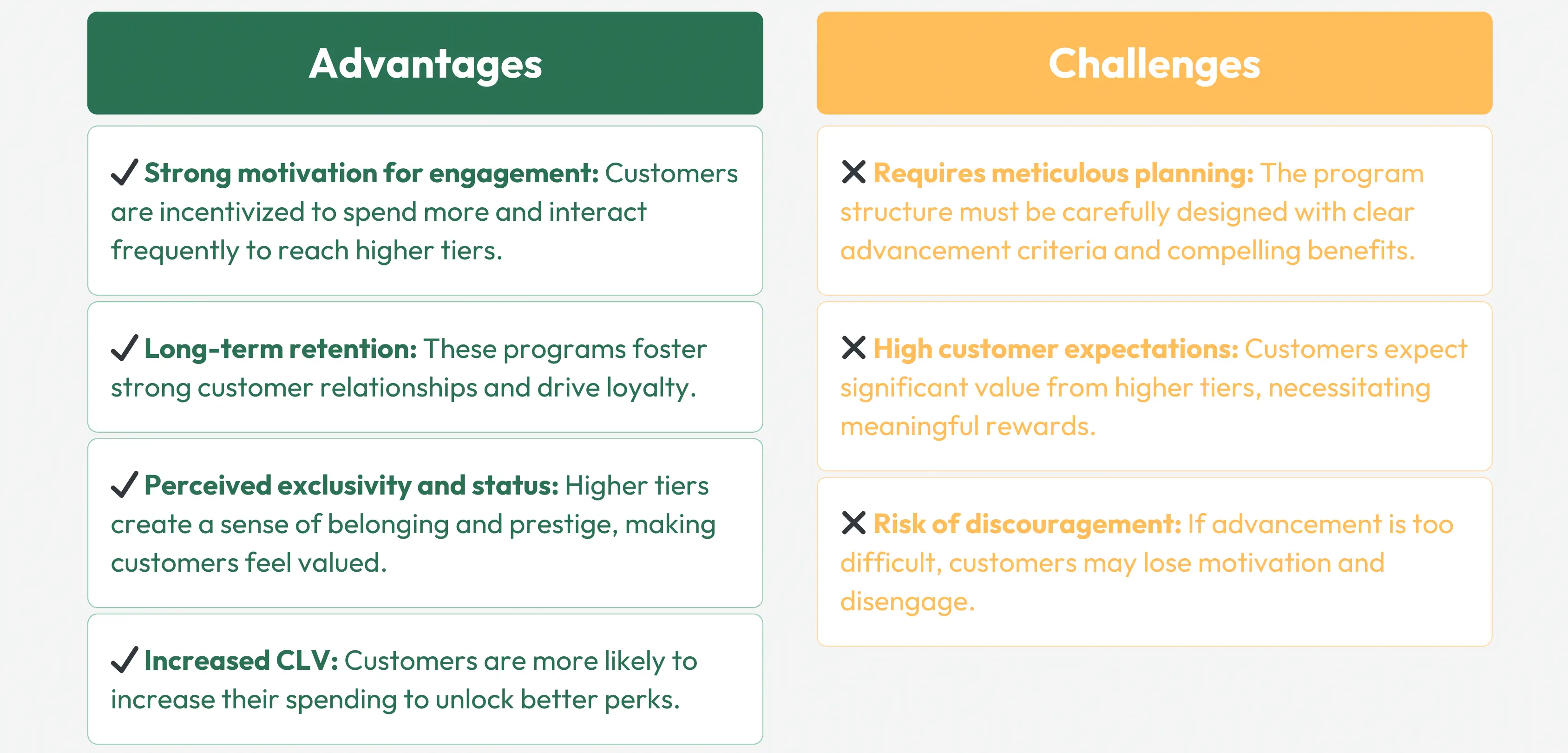
Best Practices for Creating a Successful Tiered Program
-
Define clear advancement criteria. Establish transparent and achievable requirements for moving up the tiers.
-
Offer compelling rewards. Ensure each level provides benefits that justify the effort required to attain them.
-
Communicate progress effectively. Keep customers informed about their status and the rewards they can unlock.
-
Continuously optimize the program. Regularly assess engagement data and adjust tier requirements and rewards as needed.
-
Leverage customer data for personalization. Use insights from the program to offer tailored experiences and promotions.
Tiered loyalty programs are a powerful tool for fostering customer loyalty and maximizing engagement. However, they require careful structuring and ongoing refinement to keep customers motivated and invested in the brand.
Referral Program: Turning Customers into Brand Ambassadors
A referral program is a loyalty mechanism that leverages the power of word-of-mouth recommendations. Customers are rewarded for referring your brand, products, or services to new users. It is one of the most effective ways to drive organic customer growth since potential new customers tend to trust recommendations from friends and family more than traditional advertising.
Referral programs work across various industries, but they are particularly effective in:
- Subscription-based services: Incentivizing customers to bring in long-term users.
- E-commerce and retail: Offering discounts for both referrers and new customers.
- Service-based industries: Promoting businesses that thrive on personal recommendations.
Key Features of a Referral Program
- Reward for the referrer: Customers who refer friends receive incentives such as discounts, free products, loyalty points, or exclusive content.
- Reward for the referred customer: New customers who sign up through a referral get a benefit, such as a discount on their first purchase or a free trial.
- Unique referral codes: Each customer gets a personalized referral code or link to share with others.
- Seamless sharing: Referral programs should enable easy sharing across email, social media, and messaging platforms.
- Tracking system: A reliable system to track referrals and attribute new sign-ups or purchases.
- Fraud prevention mechanisms: Implementing safeguards to prevent users from abusing the program with fake referrals.
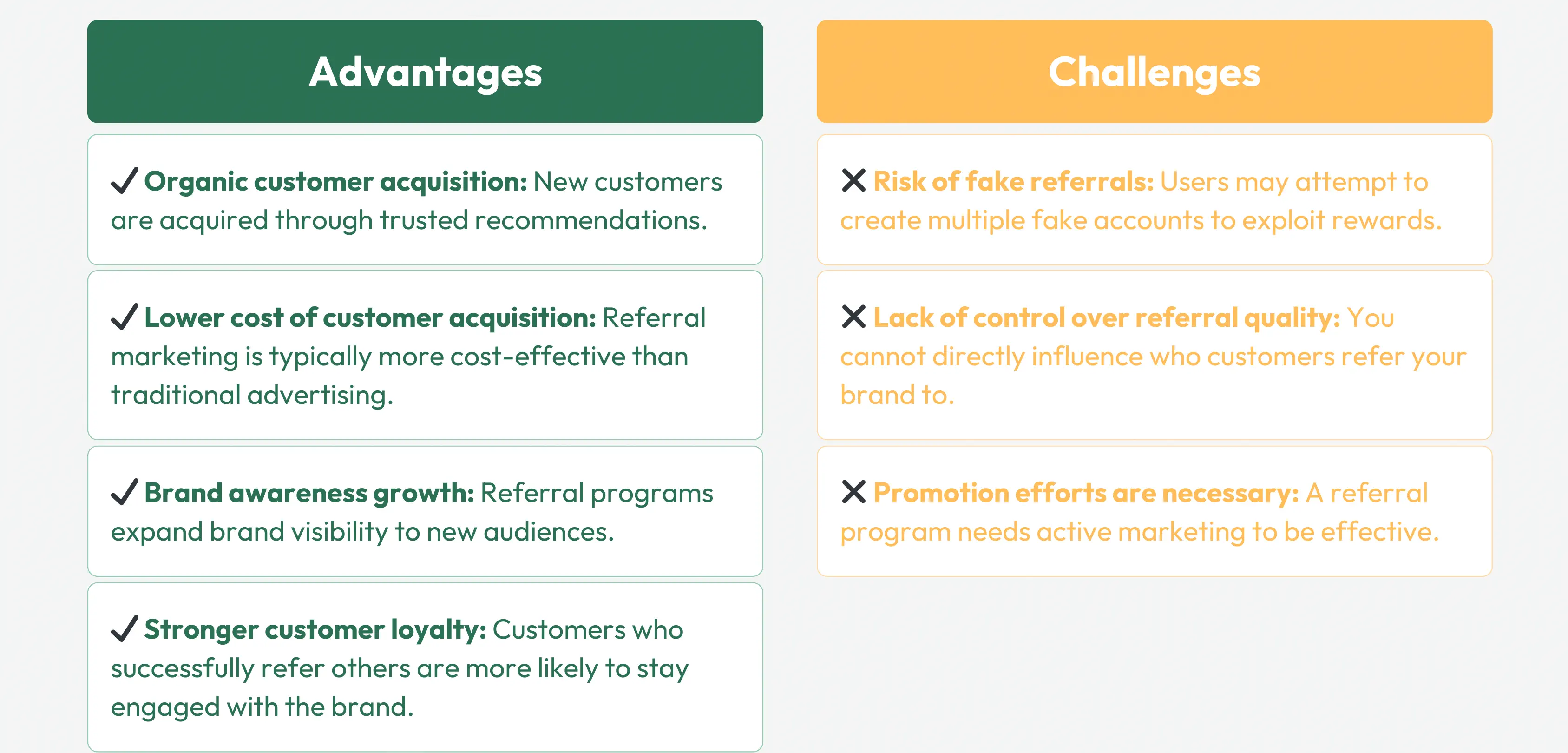
Best Practices for Creating a Successful Referral Program
-
Set clear and attractive rewards. Ensure both referrers and referred customers receive compelling incentives.
-
Simplify the referral process. Make it easy for customers to share their referral links across various channels.
-
Implement fraud detection. Use verification methods to prevent abuse and fake referrals.
-
Actively promote the program. Educate customers on the benefits of referring friends through multiple touchpoints.
-
Monitor and optimize performance. Continuously track referral metrics and refine the program based on customer engagement.
A well-structured referral program is a powerful tool for organic customer growth and loyalty building. However, its success depends on careful planning, seamless execution, and ongoing optimization.
Rewards Program: Personalized Benefits at Your Fingertips
A rewards program is a flexible loyalty mechanism that focuses on offering customers tangible benefits in exchange for specific actions. Unlike a points-based system, where customers accumulate points to redeem later, a rewards program provides immediate perks upon meeting predefined conditions. These can include discounts, free products, access to exclusive offers, or cashback—giving customers a direct incentive for their engagement.
Rewards programs are highly versatile and can be applied across multiple industries, including:
- Retail and e-commerce: Offering instant discounts, vouchers, or free shipping.
- Service industries: Providing exclusive perks such as priority access or premium experiences.
- Financial sector: Implementing cashback as a reward for transactions.
Key Features of a Rewards Program
- Tangible rewards: Customers receive clearly defined incentives for their actions.
- Instant gratification: Many rewards are granted immediately upon completing a qualifying action, boosting satisfaction.
- Flexible structure: Programs can be tailored to different customer segments and business goals.
- Personalization: Rewards can be customized based on customer preferences and behavior.
- Cashback options: Some programs offer cashback, allowing customers to recover a portion of their spending.
Types of Rewards in Loyalty Programs
- Purchase-based incentives: Customers receive rewards such as discounts or gifts based on their spending.
- Exclusive discounts: Special offers only available to loyal customers.
- Gift cards and vouchers: Redeemable in-store or through brand partnerships.
- Exclusive experiences: VIP access to events, personalized services, or early product releases.
- Cashback: A percentage of the purchase amount is returned as store credit or direct savings.
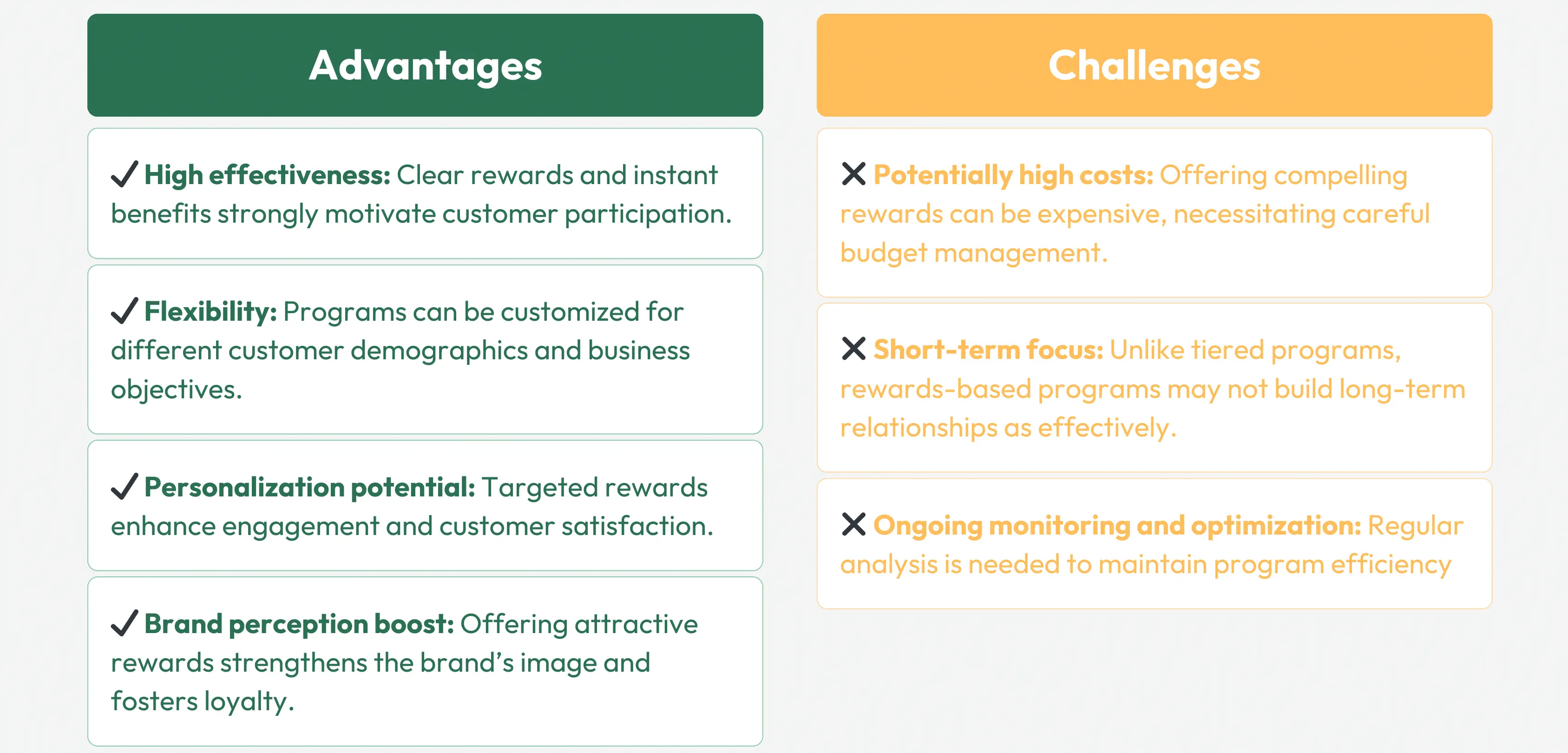
Best Practices for Creating a Successful Rewards Program
-
Define clear objectives. Determine whether the goal is to drive sales, increase engagement, or improve retention.
-
Understand your customers. Identify the rewards that will be most appealing to your audience.
-
Establish simple, transparent rules. Ensure customers clearly understand what actions will earn them rewards.
-
Offer valuable incentives. Rewards should be meaningful and desirable to encourage participation.
-
Promote the program effectively. Ensure customers are aware of the program and how to benefit from it.
-
Continuously monitor and refine the program. Regularly assess performance metrics and adjust rewards accordingly.
Cashback as a Powerful Add-On
Integrating cashback into a rewards program can significantly enhance its appeal. Customers appreciate the opportunity to recover a portion of their spending, which increases engagement and repeat purchases. Cashback can be offered for:
- Purchases of specific products or services.
- Transactions exceeding a certain value.
- Purchases made on specific days or during promotional periods.
- Referrals and brand advocacy efforts.
A well-executed rewards program, especially when combined with cashback, is an excellent strategy for boosting customer loyalty and increasing sales. However, careful planning and ongoing optimization are essential for maximizing its impact.
Subscription-Based Loyalty Programs: A VIP Experience
A subscription-based loyalty program is a strategy that builds a sense of belonging to an exclusive community. Participants gain "membership" status, unlocking special privileges, benefits, and offers unavailable to non-members. Unlike traditional points-based programs, a subscription model does not necessarily rely on earning and redeeming points—though it can incorporate them as an additional motivational element. The key focus is rewarding customer trust and loyalty by offering consistent benefits that strengthen their connection with the brand.
Subscription programs work well in industries where fostering long-term relationships and exclusivity is crucial. They are particularly popular in hospitality, dining, travel agencies, salons, and retail. However, with the right structure, they can be implemented across almost any sector.
- Hotels: Daily room cleaning, personalized service, priority booking.
- Travel agencies: Early access to vacation packages, priority customer service, and exclusive excursions.
- Salons: Priority appointment scheduling, complimentary treatments.
- Pet stores: Permanent 5% discount and exclusive member-only offers.
Key Features of Subscription-Based Loyalty Programs
- Sense of exclusivity: Members feel part of an elite group, reinforcing brand loyalty.
- Ongoing benefits: Access to consistent privileges and perks available only to subscribers.
- Personalization: Offers and communications tailored to individual member preferences.
- Tiered membership options: The ability to advance to higher membership levels, unlocking even greater benefits.
- Seamless access: Membership cards or mobile app integration for easy participation.
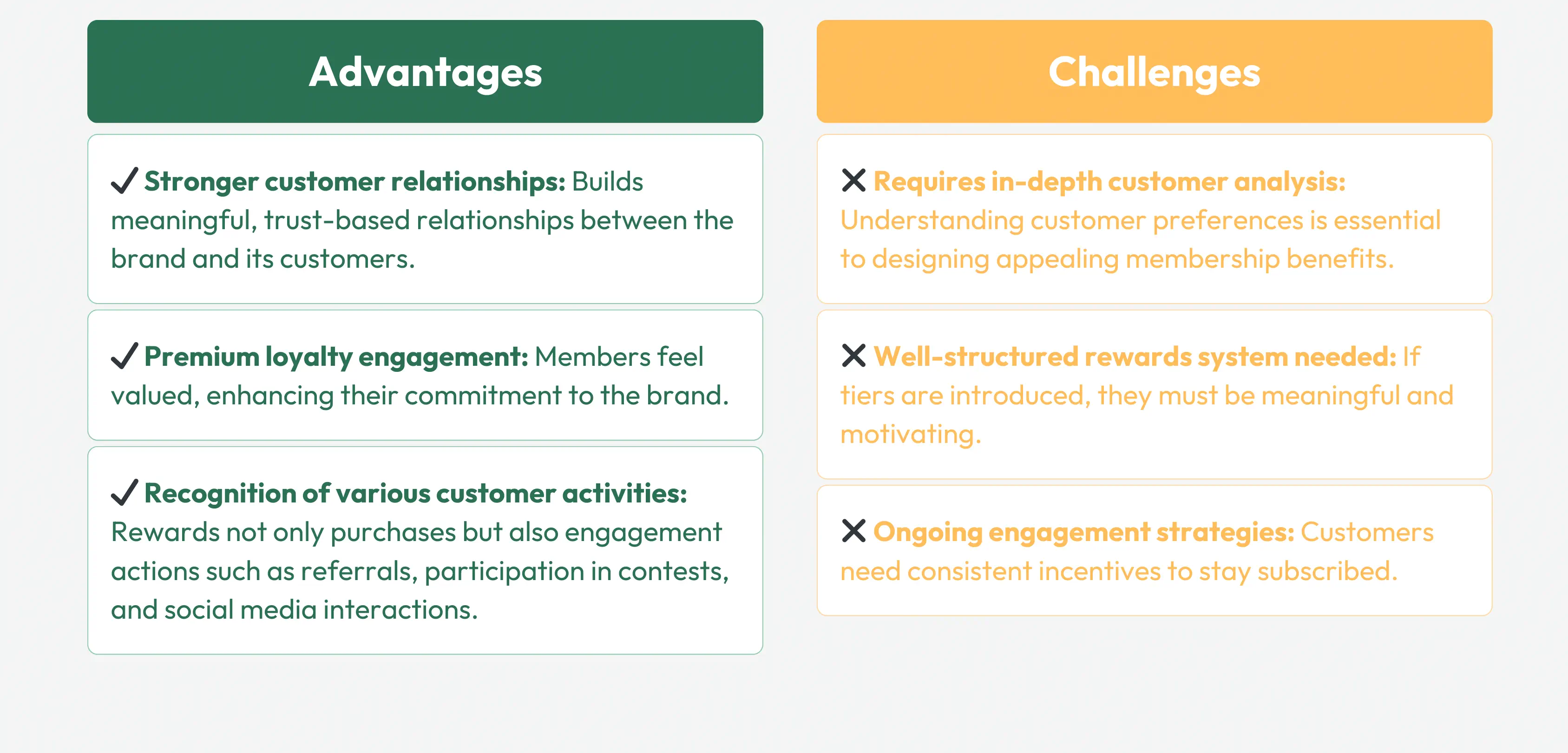
Best Practices for Creating a Successful Subscription-Based Program
-
Define the target audience. Identify who would benefit most from an exclusive loyalty program.
-
Analyze customer needs. Research what types of perks and benefits would be most attractive to your audience.
-
Design a structured membership model. Determine if the program will have multiple tiers and what benefits will be tied to each.
-
Choose the right platform. Decide whether the program will operate through a mobile app, membership card, or other digital solutions.
-
Promote the program. Ensure customers are aware of the benefits of becoming a subscriber.
-
Maintain consistent communication. Keep members informed about new perks, special offers, and exclusive events.
-
Monitor and optimize performance. Regularly evaluate program success and adapt it to meet changing customer expectations.
A well-executed subscription-based loyalty program is a powerful tool for fostering customer loyalty and deepening brand affinity. The key to success lies in understanding customer needs and delivering valuable, exclusive benefits that drive long-term engagement.
Additional Loyalty Mechanics: Enhancing Engagement and Customer Experience
Beyond core loyalty program types such as points-based, tiered, or referral programs, there are additional mechanics that can enrich the experience and drive higher engagement. Incorporating elements of fun, competition, and achievement can make the program more attractive and encourage customers to participate actively.
Gamification Mechanics
Gamification leverages game-like elements within loyalty programs to create a more engaging experience. This can include:
- Badges: Participants receive virtual badges for achieving specific milestones or completing tasks.
- Challenges: Users take on special challenges and receive rewards upon completion.
- Quests: Multi-step missions that require customers to complete specific actions in exchange for exclusive rewards.
- Virtual Currencies: In addition to loyalty points, customers can earn a unique in-program currency to redeem rewards or unlock benefits.
Competitions and Engagement-Based Rewards
Organizing competitions and incentivizing customer participation can boost engagement and create a positive brand experience. Examples include:
- Photo Contests: Customers share pictures with your product on social media, with the best submissions winning prizes.
- Brand Knowledge Challenges: Trivia-based quizzes where customers answer brand-related questions for rewards.
- Leaderboards: Customers compete against each other, earning points and climbing rankings.
Achievement-Based Rewards
Achievements serve as virtual milestones that reward customers for reaching specific goals. Examples include:
- “First Purchase” Achievement: Rewarding customers for making their first purchase.
- “Loyal Customer” Achievement: Recognizing repeat buyers who make multiple purchases in a year.
- “Brand Ambassador” Achievement: Rewarding customers who refer multiple new users.
- “Product Expert” Achievement: Given to users who write a specific number of product reviews.
Partner Offers: Expanding Loyalty Beyond Your Brand
Another powerful way to enhance loyalty programs is by integrating partner offers. Collaboration with other brands allows customers to earn and redeem rewards across multiple businesses, increasing the value of participation. Key benefits include:
- Multi-brand reward ecosystems: Customers can collect and redeem points across a network of partner companies.
- Exclusive cross-promotions: Members gain access to discounts, special offers, and premium experiences from affiliated brands.
- Extended loyalty benefits: A wider range of rewards makes the program more attractive and relevant to different customer preferences.
- Increased brand exposure: Partnering with complementary businesses helps both parties reach new customer segments.
Incorporating gamification, competitions, achievements, and partner offers can significantly enhance a loyalty program’s appeal. However, the key to success is aligning these mechanics with the nature of your industry and customer preferences. A well-designed program should not only reward customer loyalty but also deliver entertainment, excitement, and a sense of belonging—keeping your audience engaged and invested in your brand.
Hybrid Models: Combining Loyalty Mechanics for Maximum Impact
Hybrid loyalty programs offer a powerful way to engage customers by blending multiple reward mechanisms into a cohesive and compelling experience. By combining elements like points accumulation, tiered memberships, and referral bonuses, these programs create a multifaceted approach to customer retention and engagement. The beauty of hybrid models lies in their flexibility and ability to cater to diverse customer preferences.
However, the key to success with hybrid models is striking the right balance. While the combination of multiple loyalty mechanics can be powerful, it’s crucial to avoid overwhelming customers with complexity. The program structure should remain intuitive and easy to understand, with clear communication about how to earn and redeem rewards across different program elements. Transparency in point calculations, tier requirements, and benefit descriptions is essential to maintain customer trust and engagement.
By thoughtfully integrating various loyalty mechanics, you can create a program that appeals to a wider range of customers, increases engagement across multiple touchpoints, and ultimately drives stronger brand loyalty and customer lifetime value.
Integrating Loyalty Mechanics into a Holistic Customer Experience
Selecting the right loyalty mechanics is only half the battle. A truly effective program must be seamlessly integrated into the broader customer experience, ensuring personalization, omnichannel accessibility, a consistent journey across all touchpoints, and efficient communication. A loyalty program isn’t an isolated initiative but an essential part of the brand’s relationship with its customers, strengthening their emotional connection and fostering long-term engagement.
Holistic Integration
A successful loyalty program goes beyond transactional benefits, embedding itself into every facet of the customer experience. This holistic approach ensures that loyalty mechanics are not standalone features but key drivers of engagement across all customer interactions. Personalization, omnichannel connectivity, and consistent communication must work in harmony to reinforce the brand’s value proposition and create meaningful touchpoints at every stage of the customer journey.
Aligning Loyalty Mechanics with the Customer Journey
An effective loyalty program should complement and enhance each phase of the customer lifecycle. By aligning loyalty mechanics with the stages of reach, acquire, convert, retain, and advocate, businesses can create a more engaging and impactful program that drives long-term customer value.
- Reach
During the reach phase, loyalty mechanics should focus on creating awareness and attracting potential customers. This might involve leveraging social media campaigns to showcase program benefits, implementing referral incentives for existing members, or using targeted advertising to reach ideal customer profiles. The key is to highlight the program’s unique value proposition and make it stand out in a crowded marketplace.
- Acquire
In the acquisition stage, the goal is to convert interested prospects into program members. This requires a seamless onboarding process across all channels, coupled with compelling sign-up bonuses that provide immediate value. Clear communication of program benefits is crucial, as it helps potential members understand what they stand to gain by joining.
- Convert
The conversion phase aims to transform new members into active participants. This can be achieved through early engagement campaigns that guide members through program features, quick-win opportunities that demonstrate immediate value, and personalized challenges tailored to individual interests. The focus should be on creating positive early experiences that encourage continued participation.
- Retain
Retention strategies are vital for keeping members engaged over time. This might involve implementing tiered benefits that reward increased engagement, surprise-and-delight elements to maintain excitement, and personalized communications based on individual behavior and preferences. Gamification elements can also play a role in making ongoing participation more enjoyable and rewarding.
- Advocate
The final phase transforms satisfied members into brand ambassadors. This can be achieved through exclusive ambassador programs, incentives for user-generated content, and community-building initiatives that foster a sense of belonging. Actively seeking and implementing member feedback can also make advocates feel valued and heard, strengthening their connection to the brand.
By thoughtfully considering how each loyalty mechanic can be optimized for every stage of the customer journey, businesses can create a more cohesive and effective program. This holistic approach ensures that the loyalty program not only attracts new members but also nurtures them through each phase, ultimately turning satisfied customers into passionate brand advocates who drive organic growth and long-term success.
Harnessing AI to Power Next-Gen Loyalty Programs
Artificial Intelligence (AI) is revolutionizing customer engagement, and loyalty programs are no exception. AI-driven insights help brands personalize experiences, optimize reward structures, and automate interactions to maximize engagement and retention.
How AI Enhances Loyalty Programs:
- Personalized Rewards & Offers: AI analyzes customer purchasing behavior, preferences, and engagement history to suggest relevant rewards, ensuring each customer receives tailored incentives.
- Predictive Analytics for Retention: Machine learning models can predict when a customer is likely to disengage and trigger personalized retention offers to maintain engagement.
- Automated Customer Support & Chatbots: AI-driven chatbots provide instant support, track loyalty points, recommend rewards, and streamline redemptions—enhancing the overall customer experience.
- Dynamic Loyalty Tiers: AI adjusts tier levels and reward structures based on real-time customer activity, ensuring a competitive and engaging program.
- Fraud Detection & Security: AI detects unusual patterns that may indicate fraudulent activity, protecting businesses from loyalty abuse and ensuring fairness.
AI-powered loyalty programs go beyond automation—they create deeper emotional engagement by making every interaction more personalized, meaningful, and rewarding.
A truly effective loyalty program seamlessly integrates into the broader customer experience, ensuring personalization, omnichannel accessibility, and seamless communication. Brands that prioritize these elements will not only retain customers but turn them into lifelong advocates who drive sustainable growth and brand loyalty.
Conclusion: Choosing the Right Loyalty Mechanics for Your Business
Selecting the right loyalty mechanics requires a strategic approach based on business objectives, customer behavior, and available resources. While foundational mechanics like points-based programs and cashback are effective across industries, advanced mechanics such as gamification, referral incentives, and partner collaborations offer differentiation and deeper engagement.
Ultimately, a loyalty program should be more than just a retention tool—it should be a powerful driver of customer advocacy, emotional connection, and sustained business growth. By continuously optimizing, personalizing, and integrating loyalty mechanics within the broader customer experience, brands can unlock the full potential of their loyalty initiatives and build lasting relationships with their audience.
